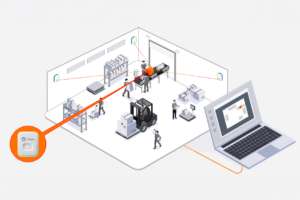Table of Contents
In the ever-changing landscape of wireless communication, Ultra-Wideband (UWB) technology has emerged as a significant advancement. Imagine a technology that is super precise, fast, and reliable. That’s what UWB tracking is bringing to the table, setting the stage for a transformation in real-time location systems (RTLS).
A Quick Introduction to Ultra-Wideband Technology
Simply put, UWB is a short-range RF technology that can pinpoint the location of people, devices, and assets with high precision. Unlike Bluetooth and Wi-Fi which use continuous signals, UWB sends out short, nanosecond pulses across a broad range of frequencies to transmit data between devices.
In practice, this means UWB-enabled devices can quickly send data over short distances and have a clear sense of where other devices are located.
Understanding UWB Positioning
UWB positioning uses a technique known as the time difference of arrival (TDoA). This method utilizes radio signals to determine the distance between the target object and multiple known reference points, made possible through the transmission of exceedingly brief pulses that span a broad frequency band.
TDoA is predicated on the principle that radio signals travel at a consistent speed – the speed of light. When a signal is emitted from a source and captured by multiple receivers, the differences in arrival times, which result from the varying distances between the source and each receiver, are measured.
The UWB system utilizes a process called trilateration, requiring at least three receivers to accurately determine the position of a target. These receivers collect and relay signal data to a central system. This system then processes the information to calculate the distance and orientation of UWB tags, often achieving remarkable precision within a few centimeters’ margins.
The level of precision offered by UWB positioning makes it a candidate for various applications, including but not limited to communication and sensor systems, indoor positioning and asset tracking, and radar systems.
Interestingly, despite UWB operating at high frequencies, its pulses can often effectively traverse certain obstacles such as walls and furniture, depending on their material and thickness. Furthermore, the broad frequency band of UWB allows for high data throughput in communication applications.
Advantages of UWB Technology
UWB technology distinguishes itself in the realm of positioning technologies through a suite of unique advantages that it offers. This analysis aims to outline the salient features of UWB technology, asserting its efficacy in various applications.
Precision in Indoor Positioning
A fundamental advantage of UWB technology lies in its high precision in indoor positioning. With accuracy within the range of a few centimeters, UWB can measure distances between devices effectively. By utilizing beacons or anchor nodes to transmit real-time location information, it provides accurate tracking of people or assets within enclosed spaces such as factories or warehouses.
Consequently, UWB technology can significantly enhance operational efficiency through improved inventory management and optimized equipment utilization.
Robust Security in Communication
UWB technology provides a high degree of security due to the characteristics of its signal. It operates at very high frequencies and uses low-power, short-duration pulses, making it difficult for traditional receivers to detect or jam, even with the most advanced interference techniques.
UWB technology employs a Time of Flight (ToF) mechanism that sends ultra-short pulses to measure the time taken for these pulses to reach the receiver. This allows for precise and reliable distance measurements. However, as with any wireless communication, the data transmitted within these pulses needs to be encrypted to ensure security. Due to these features, UWB has gained traction in industries that prioritize secure and precise communication, including military and government sectors.
High Data Rates
UWB technology stands out for its high data transmission rates on par with USB 2.0. This speed is achieved as UWB utilizes pulses that last just a few nanoseconds, ensuring swift data transfer rates. As such, UWB is suitable for applications demanding high data transfer rates, including high-resolution video streaming and virtual reality, among others.
Low Power Consumption
Designed for efficiency, UWB technology is notable for its low power consumption. UWB-enabled devices can activate ultra-low energy modes, thereby prolonging battery life in embedded applications. Due to the brevity of the pulses utilized, UWB requires minimal power to function.
Compared to continuous-connection wireless technologies like Bluetooth, UWB devices communicate intermittently, further conserving battery life.
Enhanced Accuracy in Range Detection
UWB technology boasts high accuracy in location and proximity detection, even in cluttered environments. This precision, often within a few centimeters, renders it suitable for applications such as automated doors, smart homes, and vehicle systems, among others. A device equipped with UWB technology can detect the location of other UWB devices or obstacles from a range that varies depending on many factors such as specific hardware and environmental conditions, which can exceed ten meters. This makes UWB an invaluable tool not just for proximity detection systems, but also secure communications and radar systems.
The Rising Prominence of UWB Technology Across Industries
In recent times, UWB technology has witnessed a surge in adoption by key players across diverse industries. This section evaluates the growth of UWB technology, its expanding applications, and the comparative advantages it holds over other positioning technologies.
Increasing Industry Adoption
Prominent consumer electronics manufacturers, such as Apple, Samsung, and Google have integrated UWB technology into their devices. For instance, Apple’s iPhone 11 houses the U1 ultra-wideband chip, showcasing the expanding incorporation of UWB in smartphones.
Beyond consumer electronics, UWB finds applications in unique sectors. The National Football League (NFL) utilizes UWB chips embedded in players’ shoulder pads to track real-time location and movement during games, providing granular performance analysis.
Automotive companies are increasingly exploring UWB applications to enhance user experiences such as secure, convenient access control.
Moreover, UWB hardware vendors and consortiums like the UWB Alliance and FIRA contribute to the technological development and standardization of UWB, offering diverse UWB components suitable for specific use cases.
Convergence with Emerging Technologies
Another significant trend is the convergence of UWB tracking with other emerging technologies. For instance, the integration of UWB with Augmented Reality (AR) has augmented immersive experiences, accurately superimposing virtual information onto real-world environments. Additionally, pairing UWB tracking with the Internet of Things (IoT) devices has facilitated the creation of intelligent, adaptable systems and smart environments.
Comparative Analysis with Other Positioning Technologies
While UWB offers numerous benefits, a comparison with other positioning technologies provides a more comprehensive understanding of its value proposition. Unlike infrared and ultrasound sensors, UWB-based indoor localization does not necessitate line-of-sight and remains unaffected by communication devices or external noise, owing to its high bandwidth and signal modulation.
Compared to Bluetooth Low Energy (BLE) and Wi-Fi, UWB technology exhibits marked advantages. Obstacles and signal interferences that may impact BLE and Wi-Fi signals have a negligible effect on UWB devices, allowing precise trilateration and enhanced positioning accuracy.
Additionally, the requirement for expensive equipment is eliminated with UWB, rendering it a cost-effective solution for indoor positioning and precise location data acquisition.
The growing market for indoor positioning services has found a reliable ally in UWB technology, and its role in powering experiences in various industries such as healthcare, retail, and transportation, is undeniably significant.
The Future Outlook and Emerging Trends in UWB Technology
UWB technology holds a promising future as its adoption accelerates across various industries. Many experts believe that it might eventually equal or surpass Bluetooth and Wi-Fi, positioning itself as the preferred technology for short-range communication and localization.
Emerging Trends in UWB Positioning Systems
As UWB tracking continues to evolve, several emerging trends are shaping its future. One such trend is the miniaturization of UWB technology. With advancements in microelectronics, UWB chips are becoming smaller and more power-efficient, enabling their integration into a wide range of devices and applications. This trend opens up possibilities for UWB tracking in wearables, healthcare devices, and even everyday objects such as keys or wallets.
Another emerging trend is the fusion of UWB tracking with machine learning and artificial intelligence (AI). By leveraging the power of AI algorithms, UWB tracking systems can intelligently analyze and interpret the vast amount of data generated by UWB sensors.
This enables the development of advanced tracking algorithms that can adapt to changing environments, accurately predict object movements, and optimize resource allocation. The synergy between UWB tracking and AI has the potential to revolutionize various industries, including retail, security, and smart cities.
For UWB positioning, two primary techniques can be used: Time Difference of Arrival (TDoA) and Two-Way Ranging (TWR).
Future Applications of UWB in Indoor Positioning
One of the notable trends in the future application of UWB is its integration into smart home systems. UWB-enabled devices can provide precise location data within homes, paving the way for enhanced security, automation, and personalization. For instance, doors could automatically unlock as a person approaches, or lighting could adjust based on the occupant’s location.
In the healthcare sector, UWB is forecasted to bring significant changes. Tracking tags powered by UWB could aid in locating medical equipment, tracking patients within hospitals, and facilitating efficient asset management. This technology could potentially enhance patient care, reduce equipment loss, and streamline workflows within healthcare facilities.
Furthermore, UWB technology is anticipated to play a pivotal role in advancing autonomous vehicles. By offering accurate positioning and localization capabilities, UWB could enhance safety and efficiency for self-driving cars. UWB-enabled sensors could assist with precise mapping and localization, enabling vehicles to navigate complex environments confidently.
Understanding the Challenges and Limitations of UWB Tracking
While the potential of UWB technology is promising, it’s crucial to address its limitations and challenges. This is vital for stakeholders aiming to maximize the advantages while mitigating the potential downsides.
Range Limitations
The foremost challenge of UWB tracking technology lies in its range limitations. While UWB excels in high-precision tracking within proximity, its accuracy dwindles as the distance between the object and the device widens. Such limitations render UWB less effective in tracking objects over expansive areas or in outdoor environments. The technology also faces hurdles when the tracking device is mobile.
Interference
UWB is prone to interference from other wireless devices operating in the same frequency band. As UWB uses a wide frequency range for signal transmission, it may clash with other wireless technologies such as Wi-Fi. Such interferences can result in data loss, diminishing accuracy, and faster battery depletion in UWB tracking devices.
Costs
When compared to other wireless technologies used in IoT devices, UWB technology is relatively expensive. The high cost of UWB components and tracking devices presents a hurdle for manufacturers looking to create cost-effective UWB-enabled products. This factor could limit the wider adoption of UWB technology, especially in mass-market applications like smart homes where cost considerations are pivotal for consumers.
Integration Challenges
Integrating UWB technology into existing IoT devices and infrastructure can be challenging. The complexity of UWB technology and its compatibility with other wireless technologies can present hurdles, potentially making it difficult for companies to implement UWB-enabled IoT solutions. This challenge could slow down the widespread adoption of UWB technology, especially in the industrial IoT sector.
The Impact of UWB Tracking Across Different Industries
The adoption of Ultra-Wideband (UWB) tracking location technology offers a multitude of benefits across various industries. Here are a few key sectors that stand to gain from UWB tracking:
Retail
UWB tracking revolutionizes inventory management in retail, allowing real-time tracking of inventory locations, movements, and changes in stock levels.
It also enables an in-depth understanding of customer behavior, including dwell times and purchasing preferences. By mapping customer journeys within the store, retailers can optimize store layouts and enhance customer experiences.
Construction
Construction sites can leverage UWB tracking technology to boost workflow efficiency and safety. By placing UWB tags on equipment, vehicles, and personnel, managers can monitor movements and locations, thereby streamlining resource allocation and tracking progress. Furthermore, UWB tracking aids in adhering to safety regulations and minimizes hazards such as falling objects.
Sports And Entertainment
In the realm of sports, real-time tracking of athletes’ movements provides invaluable data for performance analysis. Coupled with metrics such as heart rate monitoring, UWB tracking enables nuanced strategies and a better understanding of team dynamics.
In the entertainment industry, UWB’s precise location data can assist in seating arrangements for audiences and accurate microphone placements for live performances.
Healthcare
The healthcare industry can benefit from UWB technology in areas like patient tracking, asset tracking, and inventory management. This can streamline processes, reduce wait times, and improve patient outcomes.
Additionally, locating expensive equipment or tracking inter-departmental asset movement becomes easier with UWB. Also, inventory management can ensure essential supplies and medications are always available.
Manufacturing
Manufacturing facilities can harness UWB tracking to optimize workflows. By tracking inventory in real time, operations can be streamlined, and production adjusted as needed. Equipment performance monitoring, issue detection, and preventive maintenance facilitated by UWB tracking lead to reduced downtime and heightened efficiency.
Logistics
The logistics industry can utilize UWB tracking for vehicle tracking, routing optimization, and effective fleet management. UWB tags are placed on containers, trailers, or other assets to track their location and movements to enhance visibility.
Fleet managers can track vehicle locations for planning optimal routes and schedules, and drivers can be alerted in real time about deviations.
The Promising Future and Emerging Trends in UWB Tracking
The trajectory of UWB tracking holds immense potential, with current trends and forecasts suggesting its increasing adoption and synergy with other technologies. Its application ranges from asset tracking to indoor positioning systems, symbolizing a sea change in real-time object location and tracking.
As the miniaturization of UWB chips proceeds and the merger with AI evolves, it’s expected that UWB tracking will play an integral role in molding the future of various industries and enhancing day-to-day experiences.
When it comes to implementing these forward-looking services for your business, consider a trusted provider like Litum. Our solutions offer a balance between cutting-edge technology and personalized support. As a reliable end-to-end provider, we offer refined solutions that bring tangible results, enhance ROI, and improve overall efficiency.
Whether it’s for inventory management, asset tracking, or workflow optimization, Litum stands as a premier source for comprehensive RTLS solutions designed for today’s marketplace. With a track record of expertise and a reputation for excellence, we’re poised to assist your business both now and in the evolving future.
Visit our website for a free consultation and learn more about how we can drive your business forward.



